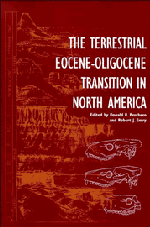Book contents
- Frontmatter
- Contents
- Contributors
- Preface
- PART I The Chronostratigraphy of the Uintan through Arikareean
- 1 Magnetic stratigraphy and biostratigraphy of the middle Eocene Uinta Formation, Uinta Basin, Utah
- 2 Biostratigraphy and magnetostratigraphy of the Bridgerian-Uintan Washakie Formation, Washakie Basin, Wyoming
- 3 Magnetic stratigraphy, sedimentology, and mammalian faunas of the early Uintan Washakie Formation, Sand Wash Basin, northwestern Colorado
- 4 Theoretical biochronology, the Bridgerian-Uintan boundary and the “Shoshonian Subage” of the Uintan
- 5 Middle Eocene mammalian faunas of San Diego County, California
- 6 Stratigraphy and paleomagnetism of the middle Eocene Friars Formation and Poway Group, southwestern San Diego County, California
- 7 Magnetostratigraphy of the upper middle Eocene Coldwater Sandstone, central Ventura County, California
- 8 Stratigraphy and paleomagnetism of the upper middle Eocene to lower Miocene (Uintan to Arikareean) Sespe Formation, Ventura County, California
- 9 Magnetostratigraphy of the Eocene-Oligocene transition in Trans-Pecos Texas
- 10 Magnetic stratigraphy of the Duchesnean part of the Galisteo Formation, New Mexico
- 11 Stratigraphy and vertebrate faunas of the Bridgerian-Duchesnean Clarno Formation, north-central Oregon
- 12 Eocene-Oligocene faunas of the Cypress Hills Formation, Saskatchewan
- 13 Magnetic stratigraphy of the White River Group in the High Plains
- 14 Magnetostratigraphy and biostratigraphy of the Eocene-Oligocene transition, southwestern Montana
- 15 The Whitneyan-Arikareean transition in the High Plains
- PART II Common Vertebrates of the White River Chronofauna
- Summary
- Index
14 - Magnetostratigraphy and biostratigraphy of the Eocene-Oligocene transition, southwestern Montana
Published online by Cambridge University Press: 06 July 2010
- Frontmatter
- Contents
- Contributors
- Preface
- PART I The Chronostratigraphy of the Uintan through Arikareean
- 1 Magnetic stratigraphy and biostratigraphy of the middle Eocene Uinta Formation, Uinta Basin, Utah
- 2 Biostratigraphy and magnetostratigraphy of the Bridgerian-Uintan Washakie Formation, Washakie Basin, Wyoming
- 3 Magnetic stratigraphy, sedimentology, and mammalian faunas of the early Uintan Washakie Formation, Sand Wash Basin, northwestern Colorado
- 4 Theoretical biochronology, the Bridgerian-Uintan boundary and the “Shoshonian Subage” of the Uintan
- 5 Middle Eocene mammalian faunas of San Diego County, California
- 6 Stratigraphy and paleomagnetism of the middle Eocene Friars Formation and Poway Group, southwestern San Diego County, California
- 7 Magnetostratigraphy of the upper middle Eocene Coldwater Sandstone, central Ventura County, California
- 8 Stratigraphy and paleomagnetism of the upper middle Eocene to lower Miocene (Uintan to Arikareean) Sespe Formation, Ventura County, California
- 9 Magnetostratigraphy of the Eocene-Oligocene transition in Trans-Pecos Texas
- 10 Magnetic stratigraphy of the Duchesnean part of the Galisteo Formation, New Mexico
- 11 Stratigraphy and vertebrate faunas of the Bridgerian-Duchesnean Clarno Formation, north-central Oregon
- 12 Eocene-Oligocene faunas of the Cypress Hills Formation, Saskatchewan
- 13 Magnetic stratigraphy of the White River Group in the High Plains
- 14 Magnetostratigraphy and biostratigraphy of the Eocene-Oligocene transition, southwestern Montana
- 15 The Whitneyan-Arikareean transition in the High Plains
- PART II Common Vertebrates of the White River Chronofauna
- Summary
- Index
Summary
ABSTRACT
Detailed magnetostratigraphic and biostratigraphic studies of Eocene-Oligocene deposits in southwestern Montana have greatly refined the dating of the fossil mammal assemblages known from the region. In the Jefferson Basin, the middle Chadronian Pipestone Springs l.f. correlates with Chrons C15r to C16r1 (35.0-35.5 Ma). The assemblages known from the middle to late(?) Chadronian Little Pipestone Creek localities correlate at least in part with Chrons C15r to C16n1 (35.0-35.4 Ma). The late Chadronian West Easter Lily l.f. and the succeeding early Orellan Easter Lily l.f. span much of Chron C13r (33.5-34.3 Ma). In the Beaverhead Basin, the early Chadronian McCarty's Mountain fauna correlates with Chrons C16r1 to C17n1 (35.5-36.7 Ma). The late Duchesnean Diamond O Ranch l.f. may correlate with part of the long episode of normal polarity during Chron C17n. In the Sage Creek Basin, the late Uintan Dell beds have produced the stratigraphically successive Douglass Draw and Hough Draw local faunas, both of which appear to fall in Chron C18r (40.2-41.0 Ma). The Matador Ranch and Cook Ranch local faunas from the stratigraphically higher Cook Ranch Formation are correlated with the Orellan part of Chron C12r (32.0-33.0 Ma).
The mammalian local faunas of southwestern Montana strongly reflect the significant faunal provincialism that characterized western North America during the Eocene-Oligocene transition. A varying percentage (generally 20-40%) of the mammalian species known from the late Uintan through late Orellan local faunas of the region appear to have been endemic to southwestern Montana.
- Type
- Chapter
- Information
- The Terrestrial Eocene-Oligocene Transition in North America , pp. 278 - 311Publisher: Cambridge University PressPrint publication year: 1996
- 18
- Cited by



